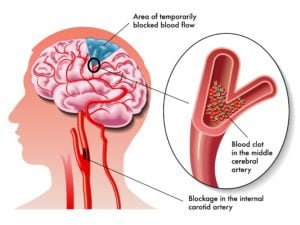If you think that you or some person who is with you has a stroke, then you must call an ambulance. If you or the person who is with you feels that the symptoms have passed, you or he should go to your doctor. You must be checked by him or her. When the symptoms of the stroke disappear in 24 hours, then this means that you had TIA (transient ischaemic attack). But this is a reason for worry because in the near future you can have full stroke. When you are at hospital, then your doctor or specialist will give you the right treatment for your condition.
How to recognize the signs of stroke?
The signs of this vary from one person to other. In the most cases they begin suddenly. We know that different parts of our brain do not control the same parts of our body. They control different parts of our body. The symptoms that we have mentioned of stroke will depend on which part of our brain was affected by the stroke and how much our brain was affected by this condition. In most cases people have symptoms which are known as FAST [1].
- F – FACE: When you have a stroke and the face was affected, then one eye can be dropped, the face can drop on one side and the individual cannot smile or the mouth can be dropped
- A – ARMS: When people have stroke which have affected their arms, then they cannot lift both arms. Also they cannot keep their arms in the air if they can lift them because they feel numbness or weakness in one arm.
- S – SPEECH: When you have stroke which have affected your speech, then your speech can be garbled or slurred. Also the individual will not be able to talk even you see him or her that is awake.
- T – TIME: If you have noticed some of the mentioned symptoms, then you must call your local ambulance because you can improve your risk of getting side effects if you do not call it immediately.
The most important thing for all of us is to know which are the signs and symptoms of this disease. If you have someone in your family who is having high blood pressure or diabetes or who is older person, then you must know the mentioned signs and symptoms.
Other possible symptoms of stroke: The symptoms which we have mentioned in FAST are the most common symptoms for this condition. But also there are other symptoms which can have people who have stroke such as
- Dizziness
- Complete paralysis of one side of the body
- Confusion
- Sudden loss or blurring of vision
- Loss of consciousness
- Difficulty understanding what others are saying
- Difficulty swallowing which is known as dysphagia
- When you have problems with the coordination and balance
- When you have sudden and severe headaches which are resulting in a blinding pain unlike anything experienced before
Mini–stroke which is known as TIA (Transient Ischaemic Attack): They have the same symptoms such as the strokes but there is a difference in them because they symptoms of TIA can last between few minutes and few hours and then they disappear completely. You might think that this is not serious condition, but you should not ignore it. When you have TIA, then you should know that there is not enough blood supply to your brain. This means that your risk of getting stroke in the near future is increased. If you have noticed that you have TIA, then you should talk with your doctor as soon as possible. [2]

Causes of stroke
There are two types of strokes known as ischaemic stroke and haemorrhagic stroke which can be caused by different causes and they affect the brain in different ways.
Ischaemic strokes:
This is the most common type of stroke. They happen when you have blood clots which block the oxygen and flow of blood to your brain. In the areas where your blood clots are appearing in the narrowed or blocked arteries is a process known as atherosclerosis. The most common risk factors for this kind of stroke are smoking, obesity, high blood pressure, too much alcohol consumption and high cholesterol levels in your body. [3,4]
Haemorrhagic strokes:
- This is not so common type of strokes. When a blood vessel which is in your skull bursts and bleeds in and around the brain, this is condition known as haemorrhagic stroke. When you have high blood pressure, then they weaken the arteries which are located in your brain which makes them to rupture and split, then you has haemorrhagic acid. Smoking, a lack of exercise, being overweight or obese, stress and drinking too much alcohol can increase the risk of this stroke. [3,5]
References:
[1] American Stroke Association. Stroke symptoms. Retrieved from www.stroke.org/en/about-stroke/stroke-symptoms
[2] Easton D, Saver JL, Albers GW, et al. Definition and evaluation of transient ischemic attack. Stroke. 2009;40:2276–93.
[3] Boehme AK, Esenwa C, Elkind MSV. Stroke risk factors, genetics, and prevention. Circulation Research. 2017;120(3):472–95.
doi:10.1161/CIRCRESAHA.116.308398
[4] World Heart Federation. Stroke and blood clots. 2017. Retrieved from www.world-heart-federation.org/resources/stroke-blood-clots/
[5] Rymer MM. Hemorrhagic stroke: Intracerebral hemorrhage. Missouri Medicine. 2011;108(1):50–4.
[…] mushrooms, then you are helping your body to burn the bad cholesterol. It is preventing from strokes, atherosclerosis and heart attacks because mushrooms are keeping the cholesterol […]